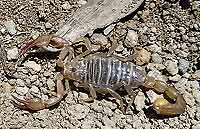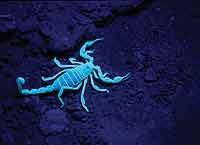 Prehistoric and bizarre are two words that often go together when describing prehistoric creatures. And in the case of the largest fossilized sea scorpion ever found in northeastern Iowa, these hold true. At five feet long, the Pentacopterus had paddle-like appendages enabling it to swim, walk or dig in Devonian oceans some 460 million years ago. Its bizarre shape reminded paleontologists of an ancient Greek warship – the penteconter – and was thus named.
Prehistoric and bizarre are two words that often go together when describing prehistoric creatures. And in the case of the largest fossilized sea scorpion ever found in northeastern Iowa, these hold true. At five feet long, the Pentacopterus had paddle-like appendages enabling it to swim, walk or dig in Devonian oceans some 460 million years ago. Its bizarre shape reminded paleontologists of an ancient Greek warship – the penteconter – and was thus named.
From this oceanic origin millions of years ago, sea scorpions moved landward. A claw-like appendage enabled them to cling to rocky shores and seaweed. Gills and developing lungs allowed them to survive in both the sea and on land. One theory is that when molting underwater, the stationary scorpions might have fallen prey to predators, but above the ocean’s surface, there were few predators to worry about. So to the land they took.
Once they went completely terrestrial, the prehistoric scorpions never looked back.
Today, these relatives of ticks, spiders and other arachnids are a common component of the desert fauna. Rarely observed, you often have to spend some energy looking for these nocturnal creatures. Turning over cow pies, lifting rocks or rolling over old woody debris are my “go tos” when searching for scorpions. 
Success is often met with a coiled tail and pincers at the ready. Scorpions don’t bite; they sting with the stinger on the tip of their tail. Though they use their defense posture as a warning, their strike can be lightning fast. The obvious lesson here is look, but don’t touch.
Roughly 20 of North America’s 70 scorpion species occur in the Southwest. The largest, the giant hairy scorpion, is named after its 5.5-inch-long size and small hairs on its legs and undersides. You might think that these scorpions pack a poisonous wallop, but they are less poisonous than their smaller cousins the Northern bark scorpion. Again, that’s not a green light to try and pick one up because everyone’s reaction to a sting may vary.
The giant hairy and other scorpions have a waxy layer over their exoskeleton that prevents dehydration and also traps ureic acid beneath this layer. In turn, when exposed to ultraviolet light, like a hand-held blacklight, the scorpions fluoresces a turquoise color due to these chemicals.
If you happen to find a pair of scorpions in each other’s grasp during a nighttime blacklighting adventure, this “promenade à deux” is the courtship waltz of the scorpion. The male is trying to navigate the female over a packet of sperm for her to vacuum up. After a gestation period of a few months to a year, 10 to 50 young are born live. They quickly climb up onto her back where they travel until their first molt in about two weeks, protected by their mother’s stinger.
Scorpions have a fairly successful life span, from several years up to 10 or 12 depending upon the species. But like most other predators in nature, they may also fall prey to other nocturnal predators. In this case, bats and owls.
So after a night of stalking prey and avoiding predators, scorpions seek a protective location to wait out another day. Sometimes that hiding place might be an unattended shoe or boot. Another good rule of thumb in the desert is to always shake out your shoes in the morning; you never know who might have taken up residence overnight.